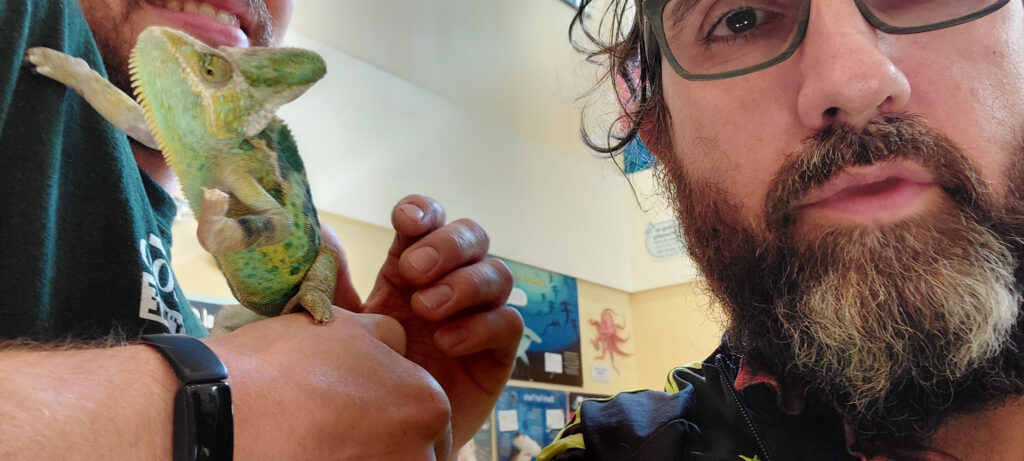Freddy Moyano
Correspondent
BROWN COUNTY – Our mid-August visit to the Northeastern Wisconsin (NEW) Zoo & Adventure Park in Suamico was guided by Animal Care specialist Drew Dinehart, who introduced us to Cosmo, a male veiled chameleon and one of their newest Zoological Education Department ambassadors.
“He is a first for us here. We had not had a chameleon [before]. He attends the Zoo classes as we have camp going on right now. He visits camp and we talk about all of the adaptations he has” said Dinehart of this curious reptile as he held it for us.
He said Cosmo came in May, through their adoption program, from a reptile rescue center in the Green Bay area.
Moody colorful creatures
Dinehart said that contrary to his belief as he grew up regarding chameleons changing skin colors solely to blend in with their surroundings, a main reason they do this, he said, is to show their mood patterns.
“If he is feeling excited, angry or territorial, he will turn into bright green color, such as when he is waiting for his mealworms. He is very calm right now,” said Dinehart regarding the bluish and grey tones Cosmo showed during our visit at the NEW Zoo. He said Cosmo’s skin color can also shift based on room temperature.

Dinehart said both males and females grow a casque on the top of their heads. The aggressive demeanor, he said, is a good way to recognize males, versus their more calmed female mates.
Dinehart said there are over 150 different species of chameleons in the world. This “veiled” kind, he said, is originally from Saudi Arabia and Yemen, which is a semi tropical/desert environment. He said Cosmo is kept in mid to upper 70 degree temperatures, although they have an additional basking area to keeping him in the 90s when needed. But that is not all.
“Summer desert dwellers as chameleons are, they require high humidity. So we have a fogger and a dripper. He likes to sit right in the mist,” Dinehart said.
Toe and eyesight disabilities
A bruised leg injury and a missing toe – causing occasional stumbling – which Dinehart described as a permanent condition, was noticeable in its right front extremity. Although Dinehart pointed out Cosmo uses his prehensile tail as a fifth foot to overcompensate his partial disability.
Dinehart suspects Cosmo had a confrontation with his previous roommate.
“He was somebody else’s pet. He was living with another male chameleon at the time. Males are very aggressive, so it is very likely he ran into trouble with his exhibit mate,” Dinehart said.
Dinehart, who also oversees and provides care for all the other reptiles (among other species) residing at the NEW Zoo, said they built a special enclosure area for Cosmo, consisting of lower branches to climb and a pad on ground level. This, he said, should help Cosmo get around more comfortably based on his disabled condition.
Part of the stumbling, Dinehart said, has to do with a noticeable puncture in the cornea of his left eye.
“We do not think he can see well with his left eye. When he shoots his tongue out for the mealworms [we feed him], at times he is way off. We noticed he only reacts when using his right eye,” said Dinehart.
Picky eater
Dinehart said this adoption did not come with a lot of information, such as Cosmo’s age, but he said he is guessing our August NEW Zoo resident is at least 2 years old, measuring about 8 to 10 inches long from head to tail.
“He weighed 140 grams [4.9 oz] last week when I put him on the scale,” Dinehart said.
Dinehart said Cosmo’s diet is very specific. While other chameleons are essentially omnivore, he said, Cosmo seems to be fixated on large sized mealworms as his main diet.
“We call them super worms. He eats about 2 a day, although it takes me a while to feed him, as he is kind of funny and particular in his own ways, taking extra time,” said Dinehart, once again pointing out the eye injury as a possible cause for this.
He said the worms they feed him are alive as chameleons react to prey movement and like a fresh kill.
Out in the wild
“Although they are popular in the pet trade world, based on most current data [I have come across],
veiled chameleons are actually doing pretty okay in the wild; [however] 30 to 50% of the other species are endangered, mostly due to habitat loss,” Dinehart said.
We noticed Cosmo showed a shake while he walked, which Dinehart described as a stealthy way they show as part of their hunting and curious process to checking things around, both in captivity and out the wild.
According to PetMD veiled chameleons don’t have very long lifespans when compared to other Old World lizards. Captive-bred females typically live up to five years and males can live up for up to eight years when kept properly.
New series and how to help
This completes our NEW Zoo resident of the month series for August. The series will follow some of the curious facts we already share in our other monthly wildlife series, the Rehabilitation Animal of the Month at the Bay Beach Wildlife Sanctuary.
Please stay tuned on next month’s resident animal and special NEW Zoo events and attractions we plan on covering.
For information as to how to stay involved and help the NEW Zoo, visit https://newzoo.org/get-involved where you will find details on volunteering, job shadowing, Eagle Scout projects, employment and other conservation opportunities.
Freddy Moyano is a wildlife expert and award-winning videographer based in Green Bay.
For more about Freddy’s award-winning wildlife videos, visit instragram.com/freddymoyanoofficial.
